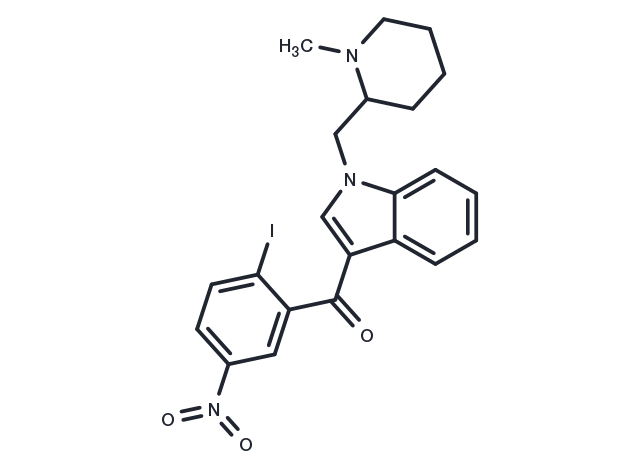Powder: -20°C for 3 years | In solvent: -80°C for 1 year
AM-1241 is a selective cannabinoid CB2 receptor agonist with Ki of 3.4 nM, exhibits 82-fold selectivity over CB1 receptor.

| 説明 | AM-1241 is a selective cannabinoid CB2 receptor agonist with Ki of 3.4 nM, exhibits 82-fold selectivity over CB1 receptor. |
| ターゲット&IC50 | CB2:3.4 nM(Ki) |
| In vitro | AM-1241 is a protean agonist of CB2 based on the different effect observed in various assays (calcium influx, extracellular signal-regulated kinase (ERK) phosphorylatin and cAMP measurement)) and on the switch from neutral antagonism to agonism in the cAMP assay when forskolin concentration is lowered. In [3H]CP 55,940 competition binding assays, AM-1241 displays high affinity at the human CB2 receptor with a Ki value of about 7 nM, whereas its affinity at the human CB1 receptor is more than 80-fold weaker, using membrane preparations from stable HEK and CHO cell lines expressing the recombinant human CB2 and CB1 receptors, respectively. [2] |
| In vivo | AM-1241 dose-dependently reverses tactile and thermal hypersensitivity produced by ligation of the L5 and L6 spinal nerves in rats. AM-1241 is also active in blocking spinal nerve ligation-induced tactile and thermal hypersensitivity in mice lacking CB1 receptors (CB1-/- mice), confirming that AM-1241 reverses sensory hypersensitivity independent of actions at CB1 receptors.[1] AM-1241 (100, 330 μg/kg i.p.) suppresses the development of carrageenan-evoked thermal and mechanical hyperalgesia and allodynia. And this suppression is blocked by CB2 antagonist SR144528 but not by CB1 antagonist SR141716A. [3] AM1241 produces dose-dependent antinociception to a thermal stimulus applied to the hindpaw, when administered into the hindpaw on the side of testing (ipsilateral i. paw), while much less active into the contralateral to the side. A50 (analgesic dose yielding a 50% effect) of AM1241 is 847 μg/kg with the maximum possible effect (100% MPE) being achieved at 3.3 mg/kg. AM1241 also produces dose-dependent antinociception when administered intraperitoneally (i.p.), with an A50 of 103μg/kg. The antinociceptive actions of AM1241 are blocked by the CB2 receptor-selective antagonist AM630, but not by the CB1 receptor-selective antagonist AM251. AM1241 dosn't produce the CNS cannabinoid effects of hypothermia, catalepsy, inhibition of activity or impaired ambulation, while this tetrad of effects is produced by the mixed CB1/CB2 receptor agonist WIN55,212-2.[4] Daily injections of AM-1241 through a i.p. route, initiated at symptom onset, increases the survival interval after amyotrophic lateral sclerosis (ALS) onset by 56% in a transgenic mouse model of ALS. [5] |
| キナーゼ試験 | Binding Assays: Binding to cannabinoid receptors is tested by using competition-equilibrium binding vs. [3H]CP55,940. AM-1241 is diluted into 25 mM Tris base (pH 7.4)/5 mM MgCl2/1 mM EDTA/0.1% essentially fatty acid-free BSA and transferred to Regisil-treated 96-well plates. [3H]CP55,940 (DuPont_NEN; specific activity 100–180 Ci/ mmol; 1 Ci =37 GBq) is added to a concentration of 0.8 nM. Membranes prepared from rat brain (containing CB1 receptors) or mouse spleen (containing CB2 receptors) are added (≈50 μg of membrane protein per well), plates are incubated at 30 °C for 1 hour, and the contents are filtered over Packard Unifilter GF/B 96-well filters by using a Packard Filtermate 196 cell harvester. Filters are washed with ice-cold 50 mM Tris base/5 mM MgCl2/0.5% BSA and dried. Bound radioactivity is quantitated and corrected for nonspecific binding, and results are normalized between 0% and 100% [3H]CP-55,940 specifically bound. IC50 is determined by nonlinear regression analysis using GraphPad PRISM and transformed to a Ki value. All data are collected in duplicate. IC50 and Ki values are determined from three independent experiments. |
| 細胞研究 | Membrane samples are prepared from HEK cells stably expressing the human CB2 receptors previously generated (Mukherjee et al., 2004), or the CHO cell line that stably expresses the human CB1 receptor. Radioligand binding assays are performed as following. Briefly, the cells are harvested and homogenized using a Polytron for 2 × 10 s bursts in a buffer containing 50 mM Tris-HCl, pH 7.4, 1 mM MgCl2, and 1 mM EDTA in the presence of protease inhibitors followed by centrifugation at 45 000 g for 20 minutes. The membrane pellets are washed and frozen at -80 °C in aliquots until use. Saturation binding reactions are performed at 30 °C for 90 minutes using [3H]CP 55,940 (0.01–8 nM) in an assay buffer containing 50 mM Tris-HCl, pH 7.4, 2.5 mM EDTA, 5 mM MgCl2, and 0.05% fatty acid free bovine serum albumin (BSA) and the reactions are terminated by rapid vacuum filtration through UniFilter-96 GF/C filter plates and four washes with cold assay buffer. Competition experiments are conducted using 0.5 nM [3H]CP 55,940 in the presence of test compounds (0.1 nM–10 μM). Nonspecific binding is defined by 10 mM unlabeled CP 55,940. KD values from saturation binding assays and Ki values from competition binding assays are determined with one site binding or one site competition curve fitting using the Prism software.(Only for Reference) |
| 分子量 | 503.33 |
| 分子式 | C22H22IN3O3 |
| CAS No. | 444912-48-5 |
Powder: -20°C for 3 years | In solvent: -80°C for 1 year
Ethanol: < 1 mg/mL (insoluble or slightly soluble)
H2O: < 1 mg/mL (insoluble or slightly soluble)
DMSO: 93 mg/mL (184.8 mM)
You can also refer to dose conversion for different animals. 詳細
bottom
Please see Inhibitor Handling Instructions for more frequently ask questions. Topics include: how to prepare stock solutions, how to store products, and cautions on cell-based assays & animal experiments, etc.
AM1241 444912-48-5 GPCR/G Protein Cannabinoid Receptor AM-1241 AM 1241 Inhibitor inhibitor inhibit
